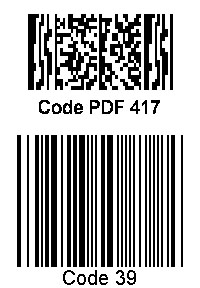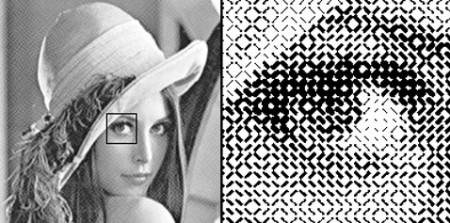DataGlyphs - encoding information in the image

The Palo Alto Research Center - PARC , a subsidiary of the famous American corporation Xerox, developed a system that allows people to combine paper documents for people with machine reading, which has a stunning advantage over the old encoding principles.
The system is called DataGlyphs .
The data is encoded as a set of diagonal strokes (the creators of the technology called them glyphs), each of which corresponds to one bit. The value of a bit depends on the direction of the glyph.
If the equipment on which the document is printed has a sufficiently high resolution, the size of the glyphs will be very small - no more than hundredths of an inch. Thanks to this, on a tiny part of the page you can fit hundreds of bytes of digital data. Afterwards, having scanned the document, this data can be extracted and decoded.
Each DataGlyph (that is, a barcode of a new type) contains a synchronization grid — regular repetition of the same set of glyphs, which marks the boundaries of the printed information and increases the reliability of reading, thanks to redundancy coding.
')
Even with a coding redundancy level of almost 30%, compared to the most common barcode standard - code39 (without duplication of information) - the new type of coding provides nearly twenty times greater data packing density: about 155 bytes per square centimeter (when printed on a printer with resolution of 600 dpi).

And even in comparison with the standard pdf417 - the most perfect barcode from previous systems - the difference is 1.8 times (in favor of DataGlyphs).
Using the variation in the thickness of the neighboring glyphs and in their color, the glyphs can be printed in black and white or color image, the "glyph" structure of which will be invisible to the eye (as we do not see points of different diameters when printing photos in a newspaper).

Reasoning further, from the glyphs you can make a gray background on text documents containing the document itself in digital form. This technology of duplex printing of the same document (one side with “letters” - for people, the second “glyphs” - for machines), is named by the developers of GlyphSeal, it has a better future. After all, now there will be no need for any printed character recognition programs to scan, say a fax.
At one of the presentations, the developers presented a prototype scanner, which is a transparent surface on which, if you place the scanner over the coded area, the coded information is displayed.
But most importantly, the technology - Open Source. Those interested can get detailed information on the project website: http://www.parc.com/research/projects/dataglyphs/
Source: https://habr.com/ru/post/14152/
All Articles